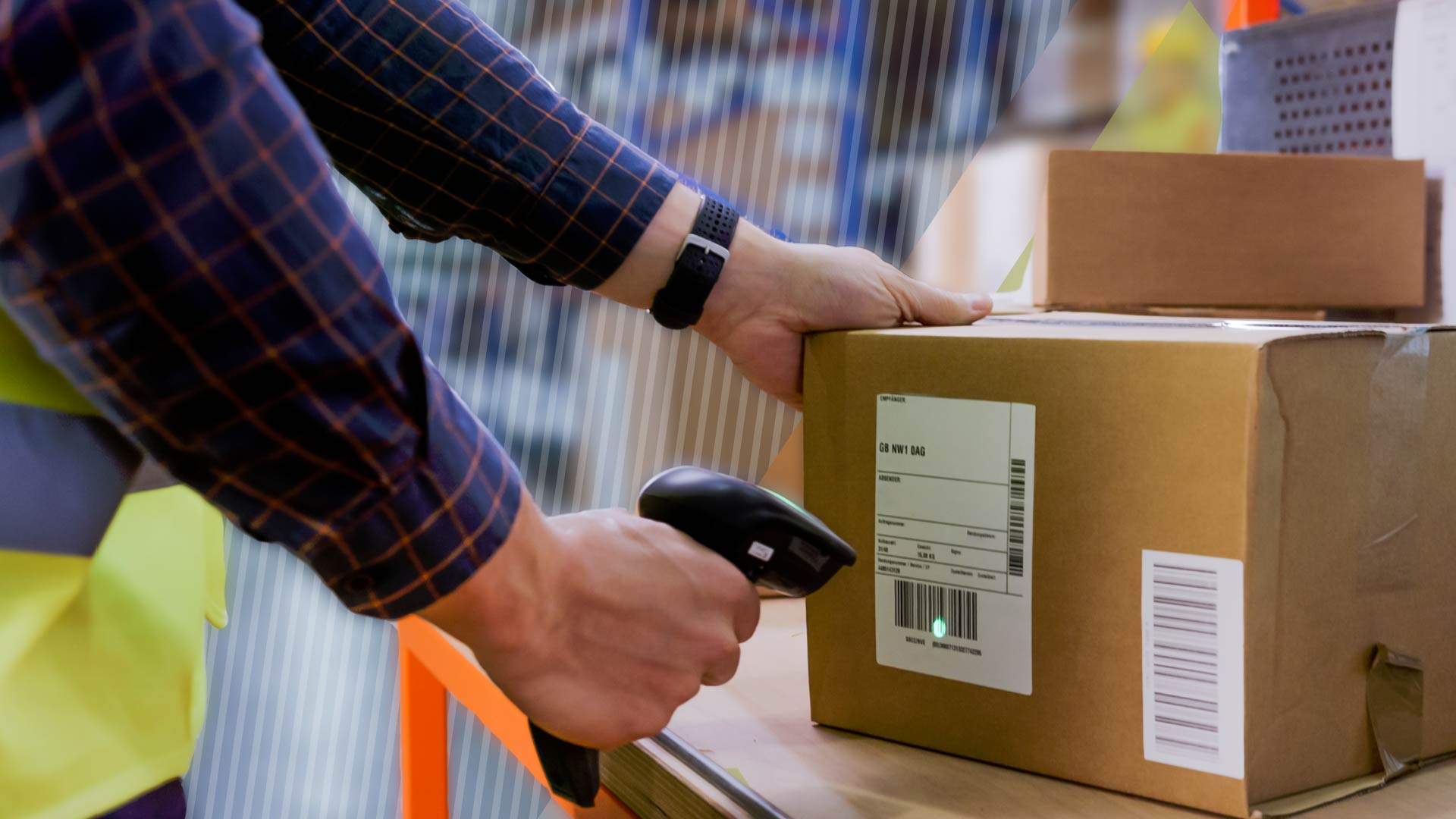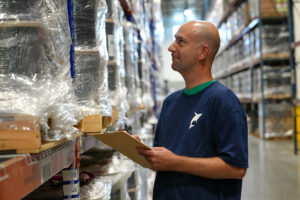The average consumer probably is unaware of the dramatic impact that technology systems have on warehousing and fulfillment, and how crucial this tech has become for maintaining efficiency, accuracy, and competitiveness in the industry. Demand for faster delivery times and a more gratifying overall customer experience has skyrocketed, and businesses are increasingly relying on sophisticated IT and operation systems to manage their complex supply chains. Warehouse management systems (WMS), transportation management systems (TMS), and machine learning are helping them streamline operations, enhance visibility, and drive informed decision-making. Here we’ll cover the common IT and operations technology systems that are revolutionizing the warehousing and fulfillment industry, highlighting their key features, benefits, and the transformative impact they have on both in-house and outsourced (3PL) modern logistics.
IT Systems
IT systems play a pivotal role in coordinating the intricate interplay of inventory management, order processing, and logistics coordination. Together these systems form the backbone of modern warehouse operations.
Warehouse Management Systems (WMS)
A Warehouse Management System (WMS) is software that has been designed to optimize the daily operations inside a warehouse. It provides a suite of tools to facilitate inventory tracking, order management, and labor management. A WMS provides real-time visibility into stock levels, allowing a warehouse to maintain accurate inventory records, minimize stockouts, and reduce excess inventory. It contains order management features that streamline the order process from receipt to fulfillment, making sure orders are picked, packed, and shipped as efficiently as possible. Additionally, WMS has labor management functionalities to help with scheduling, tracking, and optimizing workforce productivity, helping.
A WMS is used primarily to increase efficiency; by automating key processes, it reduces the time and effort required to manage inventory and fulfill orders. This automation also leads to higher accuracy, as the risk of human errors is minimized, resulting in fewer discrepancies and improved customer satisfaction. A WMS also helps a warehouse scale and easily adapt to changes in demand.
Enterprise Resource Planning (ERP) Systems
An Enterprise Resource Planning (ERP) system is a comprehensive software platform for managing and integrating the core business processes of an organization. It centralizes data across several departments, such as finance, human resources, and operations, into a single unified database where information flows seamlessly across all functions enabling better coordination and efficiency. ERP systems integrate into Warehouse Management Systems to provide a holistic view of the supply chain,allowing for real-time updates on inventory levels, order statuses, and labor availability.
An ERP system is comprised of core modules for finance, HR, and procurement.
- The finance module handles all essential costs associated with warehousing operations, budgeting, accounting, and financial reporting.
- The HR module manages workforce planning, payroll, and employee performance to make sure the warehouse is adequately staffed and that labor resources are optimized.
- The procurement module oversees the acquisition of goods and services, ensuring that inventory levels are maintained and that supplies are procured at the best possible terms. The
ERP systems centralize data, improving coordination and reducing errors. This also helps with decision-making by giving managers real-time insights and analytics.
Transportation Management Systems (TMS)
A Transportation Management System (TMS) is a specialized platform for managing and optimizing transportation logistics within a supply chain. A TMS plays a crucial role in coordinating the movement of goods from different warehouses to their final destinations, helping make sure shipments are handled efficiently and cost-effectively. Thanks to a robust set of tools for planning, execution, and monitoring of transportation activities, a TMS helps a business streamline its logistics operations, improve service levels, and reduce overall transportation costs. Due to the growing complexity of supply chains and the increasing demand for timely deliveries, the role of a TMS has become indispensable in modern logistics management.
The key functionalities of a TMS include route optimization, carrier management, and freight auditing.
- Route optimization involves determining the most efficient routes for transportation, taking into account factors such as distance, traffic, and delivery windows, helping reduce fuel consumption and transit times.
- Carrier management allows a business to evaluate and select the best carriers based on performance, cost, and service level agreements, ensuring that shipments are entrusted to reliable partners.
- Freight auditing helps verify transportation invoices against contractual agreements to ensure accuracy and identify any discrepancies.
A TMS helps reduce shipping costs through optimized routes and carrier selection, improve delivery times due to efficient planning and execution, and enhance visibility into the transportation process, allowing for better tracking and management of shipments.
Order Management Systems (OMS)
An Order Management System (OMS) is essential software that facilitates the order fulfillment process, from order entry to delivery. The primary function of an OMS is to manage and process customer orders efficiently, ensuring that each order is accurately captured, processed, and fulfilled in a timely manner. The OMS is an important part of the order fulfillment process because it directly impacts customer satisfaction and operational efficiency. By automating and streamlining order management, the OMS reduces manual errors, speeds up order processing, and provides real-time visibility into order status.
An OMS has features to facilitate order entry, order processing, and order tracking.
- Order entry allows a business to capture orders from multiple channels, such as e-commerce websites, mobile apps, and call centers, ensuring a seamless customer experience.
- Order processing involves managing the various steps required to fulfill an order, such as inventory allocation, picking, packing, and shipping.
- Order tracking provides real-time updates on the status of each order, from the moment it is placed until it is delivered to the customer, allowing both the business and the customer to monitor progress.
An OMS integrates seamlessly with other systems like WMS and ERP, and TMS systems. This network of integrations makes sure that inventory levels are accurately reflected, orders are processed efficiently, and shipments are managed effectively, creating a cohesive and streamlined operation that enhances overall productivity and customer satisfaction.
Inventory Management Systems (IMS)
An Inventory Management System (IMS) is a specialized piece of software designed to oversee and control inventory levels, helping maintain the right amount of stock to meet customer demand without incurring excess costs. It focuses on inventory control by providing tools and processes to track inventory in real-time, manage stock levels, and streamline inventory-related operations. This system plays a crucial role in optimizing the supply chain by ensuring that inventory is accurately accounted for and that replenishment processes are efficient and timely.
The key functionalities of an IMS include stock monitoring, replenishment alerts, and inventory reporting.
- Stock monitoring allows a business to keep track of inventory levels in real-time, ensuring that stock quantities are always up-to-date and accurate.
- Replenishment alerts are automated notifications that inform managers when stock levels fall below a predefined threshold, prompting timely reordering to avoid stockouts.
- Inventory reporting provides detailed insights and analytics on inventory performance, including metrics such as turnover rates, holding costs, and demand trends.
An IMS helps keep accurate inventory levels, preventing both stockouts and overstocks, and ensuring that products are available when (and only when) needed. Fewer stockouts mean better customer satisfaction, while reduced overstocks minimize storage costs and waste. An IMS also helps improve demand forecasting by using data-driven insights, helping businesses anticipate market trends and adjust inventory strategies accordingly.
Customer Relationship Management (CRM) Systems
A Customer Relationship Management (CRM) system helps a business manage and analyze customer interactions and relationships throughout the customer lifecycle. The primary role of a CRM system is to provide a centralized platform where all customer-related information is stored and accessible, including contact details, purchase history, preferences, and interaction timelines. A CRM system helps businesses better understand their customers, anticipate their needs, and personalize their interactions.
Key features of CRM systems include customer data management, sales tracking, and customer support functionalities.
- Customer data management ensures that all customer information is organized and easily retrievable.
- Sales tracking features monitor sales activities and performance.
- Customer support functionalities help streamline the resolution of customer inquiries and issue resolution.
A CRM system supports warehousing and fulfillment operations by enhancing customer service and managing returns more efficiently. CRM systems can integrate with other operational tools like a WMS and an OMS, helping to ensure that customer orders are processed smoothly and accurately. A CRM system also facilitates the management of returns by tracking return requests and processing them through the appropriate channels.
Supply Chain Management (SCM) Systems
A Supply Chain Management (SCM) system is a comprehensive software solution that oversees and optimizes the flow of goods, information, and finances across the entire supply chain network. These systems play a central role in coordinating supply chain activities, ensuring that products are sourced, produced, and delivered to customers in a timely and cost-effective manner. An SCM system provides end-to-end visibility into supply chain operations, enabling a business to monitor and manage every stage of the process from raw material procurement to product delivery. The SCM facilitates collaboration and communication across stakeholders, helps streamline workflows, reduces lead times, and improves overall supply chain efficiency.
Key modules of SCM systems include supplier management, procurement, and demand planning.
- Supplier management modules allow a business to manage relationships with suppliers, track supplier performance, and ensure that goods are sourced from reliable and reputable vendors.
- Procurement modules facilitate the purchasing process by automating procurement workflows, managing supplier contracts, and optimizing purchasing decisions.
- Demand planning modules help a business forecast customer demand, anticipate market trends, and optimize inventory levels to meet customer needs while minimizing excess inventory.
The SCM helps make sure the supply chain operates smoothly and efficiently, from procurement to delivery.
Ecommerce Platforms
Ecommerce platforms play a critical role in the warehousing and fulfillment ecosystem, serving as the digital storefronts through which businesses sell their products to customers online. They are essential for reaching a global audience, expanding market reach, and driving revenue growth. These platforms provide a business with a centralized platform to showcase its products, manage online sales, and process transactions. Ecommerce platforms allow businesses to enhance their online presence, improve customer engagement, and capitalize on the ubiquity of online shopping.
Ecommerce platforms contain features for product listings, shopping carts, and payment processing capabilities.
- Product listings allow a business to showcase its products with detailed descriptions, images, and pricing information, making it easy for customers to browse and compare products.
- Shopping carts let customers add items to a virtual cart and then proceed to checkout seamlessly.
- Payment processing functionalities securely handle transactions, supporting various payment methods and providing a smooth and secure payment experience for customers.
Ecommerce platforms integrate with the other IT systems listed earlier in this article to facilitate seamless operations, making sure that orders placed are efficiently processed, fulfilled, and delivered.
Analytics and Business Intelligence (BI) Systems
Analytics and Business Intelligence (BI) systems are instrumental in empowering decision-makers within warehousing and fulfillment with actionable insights derived from data analysis. These systems play a vital role in transforming raw data into meaningful information, enabling stakeholders to make informed decisions and drive operational excellence and strategic growth. BI systems gather and analyze data from various sources within the supply chain, including inventory management systems, order management systems, and transportation management systems. BI systems can provide a comprehensive view of key performance indicators (KPIs), trends, and patterns, empowering decision-makers to identify opportunities for improvement and optimize operational processes.
BI systems include functionality for data visualization, reporting, and predictive analytics.
- Data visualization allows users to explore and understand data through interactive charts, graphs, and dashboards.
- Reporting capabilities enable stakeholders to generate customized reports and analyze performance metrics across different dimensions, such as sales, inventory turnover, and order fulfillment rates.
- Predictive analytics functionalities utilize historical data and statistical models to forecast future trends and outcomes, enabling a business to anticipate demand, optimize inventory levels, and make proactive decisions.
A BI system facilitates informed decision-making by providing stakeholders with timely and accurate insights into key performance metrics and trends. They also help identify patterns and trends that may not stand out using traditional analysis methods, helping businesses adapt quickly to changing market conditions.
Cybersecurity Systems
A cybersecurity system is essential in modern warehousing and fulfillment operations. It helps safeguard sensitive data and maintains the integrity and confidentiality of information within the supply chain. With the increasing digitization of warehouse operations and the interconnectedness of IT systems, cybersecurity systems play a critical role in protecting warehouses and fulfillment centers from a wide range of cyber threats, including data breaches, ransomware attacks, and malicious intrusions. Key components of cybersecurity systems include firewalls, intrusion detection systems (IDS), and data encryption technologies.
- Firewalls act as a barrier between internal networks and external threats, monitoring and filtering incoming and outgoing network traffic to prevent unauthorized access and malicious attacks.
- Intrusion detection systems (IDS) analyze network traffic and detect suspicious activity or anomalies, alerting security personnel to potential security breaches.
- Data encryption technologies encrypt sensitive information to protect it from unauthorized access, ensuring that even if data is intercepted, it cannot be read without the appropriate decryption key.
Best practices for maintaining robust cybersecurity in warehousing and fulfillment operations require conducting regular cybersecurity audits to identify vulnerabilities and weaknesses, providing ongoing employee training to raise awareness about cybersecurity risks and best practices, and establishing secure network architectures with strong authentication protocols and access controls. These systems help businesses mitigate the risks posed by cyber threats and protect their assets, reputation, and bottom line.
Operations Technology
Operations technology encompasses the physical and automated tools that facilitate the day-to-day activities within a warehouse. These technologies may include advanced robotics, automated storage and retrieval systems (AS/RS), and Internet of Things (IoT) devices. Designed to enhance efficiency, accuracy, and safety in warehouse operations, they help create a cohesive, efficient, and responsive operational environment that is capable of meeting the demands of today’s fast-paced logistics needs.
Automated Storage and Retrieval Systems (AS/RS)
An Automated Storage and Retrieval Systems (AS/RS) automates the storage and retrieval of goods within a warehouse environment. These systems use a combination of robotic technology, conveyors, and computer-controlled mechanisms to efficiently store and retrieve items from designated storage locations. AS/RS typically consists of storage racks, automated storage and retrieval machines (AS/RS cranes or shuttles), and a central control system. When goods need to be stored, the AS/RS crane or shuttle transports the item to the appropriate storage location within the storage rack. For item retrieval, the AS/RS crane or shuttle collects the item from its storage location and delivers it to the designated pick-up point, ready for shipment or further processing.
There are several types of AS/RS systems, each designed to accommodate different storage requirements and operational needs.
- Unit-load AS/RS systems are suitable for handling large quantities of uniform products stored on pallets or containers.
- Mini-load AS/RS systems are designed for smaller items and high-density storage, utilizing smaller cranes or shuttles to handle individual totes or bins.
- Carousel-based AS/RS systems consist of rotating shelves or trays that move horizontally or vertically to bring items to the picking area.
- Crane-based AS/RS systems use overhead cranes to transport goods between storage locations and pick-up points.
AS/RS systems help a warehouse optimize space through high-density storage configurations, increase speed and throughput by using automated processes, and enhance accuracy in inventory management and order fulfillment.
Barcode and RFID Technology
A Barcode and Radio-Frequency Identification (RFID) technology provides efficient and accurate methods for inventory management and tracking. Barcode scanning systems utilize printed labels with unique barcodes that encode product information, such as SKU numbers or serial numbers. These barcodes are scanned using handheld barcode scanners or fixed scanners installed at various checkpoints within the warehouse. By scanning barcodes, warehouse staff can quickly and accurately ID and track individual items as they move through the facility.
RFID technology utilizes radio waves to transmit data wirelessly between RFID tags and readers. RFID tags are embedded with electronic chips that store product information, which can be read remotely by RFID readers without line-of-sight contact. This enables rapid and automatic identification of items, even in bulk or at a distance. RFID tags can store more information than barcodes and are also more durable, being able to withstand harsh environmental conditions.
Both barcode and RFID technologies provide numerous benefits to inventory management and tracking in a warehouse. They enable real-time visibility into inventory levels, streamline picking and packing processes, and reduce errors associated with manual data entry. RFID offers additional benefits, like faster and more automated data capture, enhanced traceability, and the ability to track items in real-time without physical intervention. These systems allow warehouses to improve operational efficiency, reduce costs, and enhance overall supply chain visibility and control.
Robotics and Automation
Robotics and automation are transforming warehousing and fulfillment operations, improving the way goods are handled, stored, and transported within facilities. There are many types of robots commonly used in warehouses, including Autonomous Mobile Robots (AMRs), Automated Guided Vehicles (AGVs), and Collaborative Robots (cobots).
- AMRs are self-guided robotic vehicles equipped with sensors and navigation systems that enable them to autonomously navigate warehouse environments, transporting goods between storage locations and pick-up points.
- AGVs are similar but typically follow predetermined paths or magnetic tracks within the warehouse.
- Cobots are designed to work alongside human operators, assisting with tasks such as picking, packing, and palletizing.
Robots can perform a variety of functions in warehousing and fulfillment, streamlining operations and enhancing efficiency across the supply chain.
- In picking operations, robots can autonomously navigate aisles, identify and retrieve items from shelves, and deliver them to packing stations for further processing.
- In packing operations, robots can assist with tasks such as sorting, packaging, and labeling items for shipment, reducing manual labor and increasing throughput.
- Robots can also be used for transportation tasks, moving goods between different areas of the warehouse or even between warehouse facilities.
Robotics help increase efficiency, reduce labor costs, and improve accuracy in warehousing and fulfillment tasks. By automating repetitive and labor-intensive tasks, robots enable warehouses to operate more efficiently, reduce errors, and meet the growing demands of modern supply chain dynamics.
AI and Machine Learning
AI and machine learning are emergent technologies driving significant advancements in warehousing and fulfillment. They allow a business to leverage data-driven insights and predictive analytics to optimize operations and enhance efficiency.
- Predictive analytics leverage AI algorithms to analyze historical data to identify patterns, trends, and anomalies, enabling a business to anticipate future demand, identify potential issues, and make proactive decisions.
- Demand forecasting uses machine learning models to analyze factors such as historical sales data, market trends, and external influences to predict future demand with greater accuracy.
- AI-powered inventory optimization algorithms help a business maintain optimal inventory levels by predicting demand fluctuations, identifying slow-moving or obsolete inventory, and optimizing replenishment strategies to minimize stockouts and overstocks.
AI can be applied in warehousing and fulfillment tasks such as smart order routing, which uses algorithms to dynamically allocate orders to the most appropriate fulfillment centers or warehouses based on factors such as inventory levels, proximity to customers, and shipping costs. Dynamic order prioritization uses real-time data to prioritize orders based on factors such as order value, delivery deadlines, and customer preferences, ensuring that high-priority orders are processed and shipped quickly.
In the near future, AI and machine learning are set to play an even greater role in transforming warehousing and fulfillment operations. New technologies include the integration of AI with Internet of Things (IoT) devices to enable real-time monitoring and optimization of warehouse operations, the use of AI-powered robotics to automate picking, packing, and transportation tasks, and the development of AI-driven predictive analytics models that can anticipate market trends and customer behavior with unprecedented accuracy.
Internet of Things (IoT)
The Internet of Things (IoT) connects physical objects and devices to the internet, enabling real-time monitoring, data collection, and analysis. In warehousing, IoT devices are embedded with sensors and actuators that collect data on various aspects of operations, such as inventory levels, equipment status, and environmental conditions. This data is then transmitted over the internet to a centralized platform where it can be analyzed and used to optimize warehouse operations. IoT devices play a crucial role in enhancing inventory visibility and real-time monitoring, providing businesses with insights into the location, condition, and movement of goods throughout the supply chain.
One of the primary benefits of IoT in warehousing and fulfillment is improved inventory visibility, as IoT devices enable businesses to track the location and status of inventory in real-time. IoT-enabled RFID tags can be attached to individual items or pallets, allowing businesses to monitor the movement of goods throughout the warehouse and supply chain. IoT devices can also provide real-time monitoring of environmental conditions such as temperature and humidity, helping keep perishable goods stored under optimal conditions to prevent spoilage.They can also be used to monitor equipment and machinery in the warehouse, detecting issues and performing predictive maintenance to prevent costly downtime and repairs.
Computer Vision
Computer vision is a set of technologies that allow machines to interpret and understand visual information from images or video feeds. Computer vision systems in warehouses utilize cameras and image processing algorithms to analyze images of inventory, products, and warehouse environments. These systems can perform a variety of tasks, including automated inventory tracking, quality control, and object recognition. This allows a warehouse to automate manual processes, improve accuracy, and enhance operational efficiency.
One key application of computer vision in warehousing and fulfillment is in automated inventory tracking, which allows a machine to scan and analyze images of shelves, pallets, or storage bins to identify and track the location of individual items in real-time. This eliminates the need for manual counting or barcode scanning, reducing errors and speeding up the inventory management process. Computer vision technology can also be used for quality control purposes by helping identify damaged or defective items as they move through the warehouse.
Drones and Unmanned Aerial Vehicles (UAVs)
Drones and Unmanned Aerial Vehicles (UAVs) are emerging as innovative tools in warehousing and fulfillment, offering a range of applications to streamline operations and improve efficiency. These aerial vehicles are equipped with cameras, sensors, and navigation systems, allowing them to fly autonomously or under remote control to perform various tasks within a warehouse.
THese drones can be used to conduct inventory audits, where they can quickly and accurately scan shelves and storage areas to count inventory and verify stock levels. Drones can also be used for surveillance purposes, providing real-time monitoring of warehouse facilities to enhance security and safety. They can even assist in locating specific items within the warehouse by capturing aerial images and providing visual cues to guide warehouse personnel to the desired location.
The use of drones can help a warehouse increase efficiency, reduce labor costs, and improve accuracy in inventory management. Since drones can cover large areas of the warehouse in a fraction of the time it would take for human workers to perform the same tasks manually, faster inventory audits and reduced downtime is possible. They can also access hard-to-reach or hazardous areas of the warehouse, such as high shelves or narrow aisles, without posing risks to human safety. However, there are also challenges associated with the use of drones in warehousing, including regulatory compliance, safety concerns, and the need for specialized training and expertise to operate and maintain drone fleets.
Cloud Computing and Big Data Analytics
Cloud computing and big data analytics are data processes and technologies that have rapidly shifted how warehouses and fulfillment companies operate by providing scalable, accessible, and cost-effective solutions for managing and analyzing vast amounts of data.
- Cloud computing is critical in centralizing data storage and computing resources accessible via the internet. With cloud-based solutions, a warehouse can securely store and manage its data in off-site servers, eliminating the need for costly on-premises infrastructure. Cloud computing also offers scalability, allowing warehouses to easily scale up or down their computing resources based on changing demand, ensuring optimal performance and efficiency.
- Big data analytics is essential for data-driven decision models in warehousing and fulfillment operations. By analyzing large volumes of data collected from various sources within the supply chain, such as inventory management systems, order management systems, and transportation management systems, a warehouse can gain valuable insights into their operations and performance. These analytics enable warehouses to identify trends, patterns, and anomalies in their data, helping them make informed decisions to optimize processes, reduce costs, and improve customer satisfaction.
WMS and OMS systems are cloud-based solutions, offering real-time visibility, scalability, and accessibility from anywhere there is an internet connection.
Wearable Technology
Wearable technology was once a niche technology that is increasingly finding its place in warehousing and fulfillment operations. It offers a range of devices designed to enhance worker productivity and efficiency, including smart glasses and wrist scanners.
- Smart glasses equipped with augmented reality (AR) technology can provide warehouse workers with hands-free access to information, such as picking instructions or inventory data, overlaid onto their field of view.
- Wrist scanners enable workers to quickly and easily scan barcodes or RFID tags without the need for handheld scanners, streamlining picking, packing, and inventory management tasks.
Wearable technology allows for hands-free operation, giving workers access to information and the ability to perform tasks while keeping their hands free, improving worker safety and productivity. These wearable devices can also reduce the need for manual data entry, helping to minimize distractions and errors in warehouse operations.Wearable technology is expected to continue to evolve, with advancements in areas such as biometric sensors, real-time location tracking, and integration with other smart devices.
Technology and the Future of Fulfillment
The integration of technology and IT systems in warehousing and fulfillment is necessary to meet the evolving demands of modern supply chains. These technologies offer appealing opportunities to enhance efficiency, accuracy, and visibility throughout the supply chain. Warehouses take advantage of these systems to streamline operations, optimize inventory management, and improve customer service–ultimately gaining a competitive edge in today’s dynamic marketplace.




